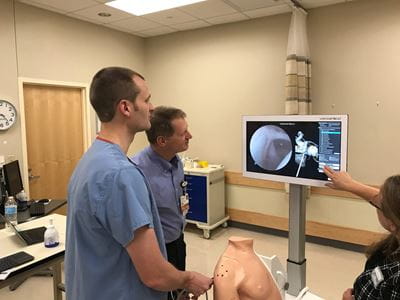Practice makes perfect, especially when it comes to surgical procedure. The IU School of Medicine Department of Orthopaedic Surgery received a $200,000 grant to fund a new state-of-the-art training tool, allowing faculty, fellows and residents to establish proficiency in surgical technique in a low-risk environment.
The VirtaMed arthroscopy simulator provides hyper-realistic simulation for the advancement of surgical skillsets in arthroscopy and endoscopy procedures. These procedures are used to diagnose and treat conditions of a joint body cavity through the minimally-invasive insertion of a fiberoptic camera with the projection of real-time imagery on a video monitor.
“The arthroscopic simulator is a phenomenal tool to help our learners build surgical skill in areas that have traditionally had limited hands-on training,” said Dan Wurtz, MD, chair for the Department of Orthopaedic Surgery. “This real-time patient simulation of a multitude of clinical scenarios, combined with expanded access, will significantly improve our resident training in arthroscopy. We are fortunate to have this unique tool to further our resident surgical training and pursue novel ways to measure improvement in surgical skills.”
The simulator consists of three real-life, interchangeable rubber models providing opportunities to practice arthroscopy/endoscopy procedures on the knee, hip and shoulder. With these models comes a series of modules and tasks specific to individual procedures. For example, using real instruments found in the operating room, faculty and trainees may utilize the knee model to diagnose an ACL tear, remove the injured ligament and discover optimal locations to drill holes in the femur and tibia bones for the replacement graft.
Alongside the physical models and interactive modules, faculty and trainees benefit from accompanying didactic slides while performing a procedure, individualized proficiency exams and a customizable training curriculum, and performance assessments that include feedback from medical experts based on best practices for each procedure performed. From perfecting basic surgical skills, to mastering complete therapeutic procedures, trainees can progress at their own pace as they gain the necessary proficiency to move on.
“Having the simulator on the Indianapolis campus puts our faculty and students at a unique advantage,” said Greg Gaski, MD, assistant professor of orthopaedic surgery. “It allows surgeons to train at their own speed, focusing on their own areas of opportunity to accelerate their technical competence, and ultimately resulting in enhanced patient care.”
IU School of Medicine is one of approximately a dozen institutions across the country have access to this level of technology. The VirtaMed arthroscopy simulator is available to orthopaedic surgery faculty and students seven days a week, and is located in the IU Health Fairbanks Simulation Center.




